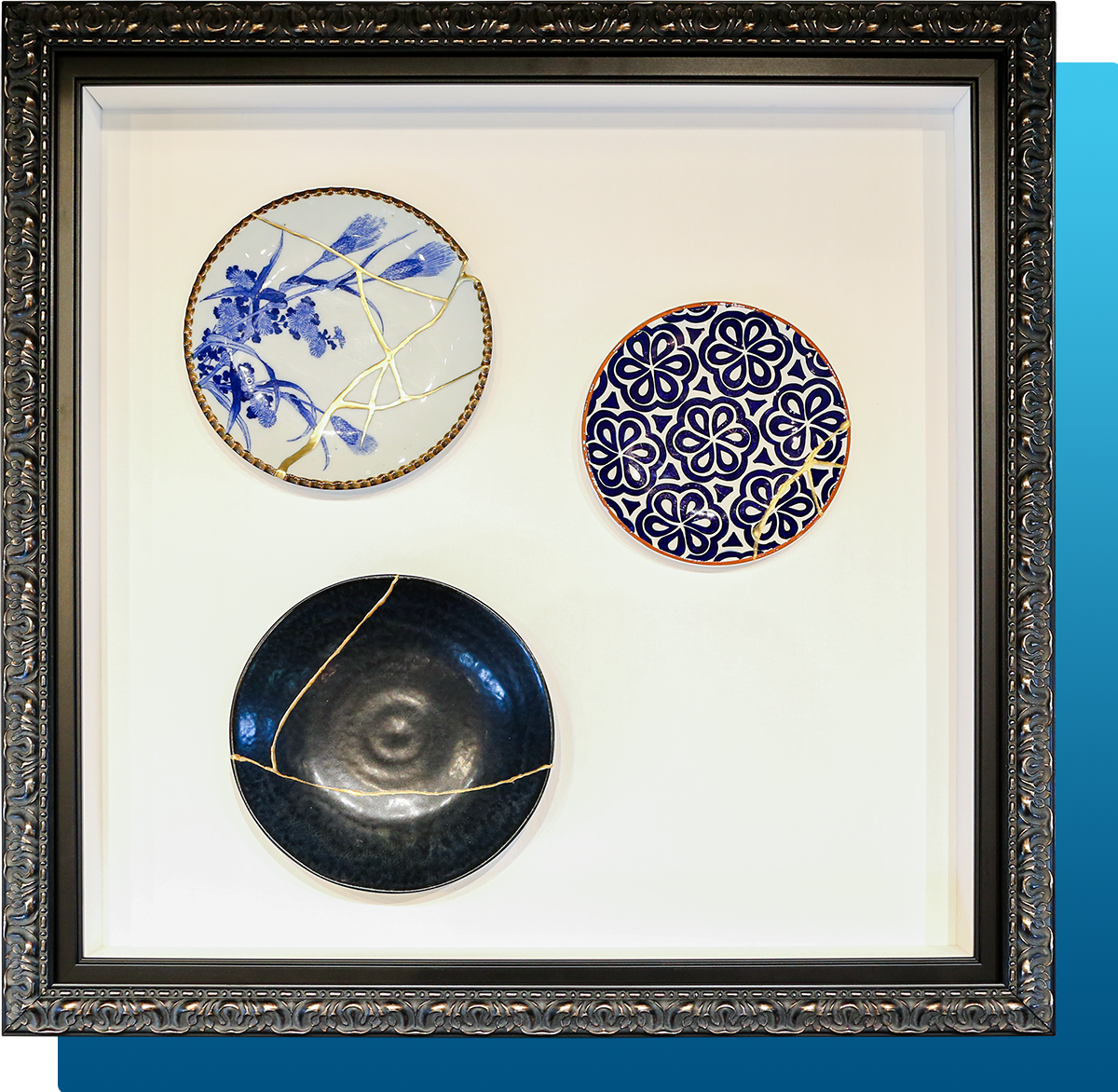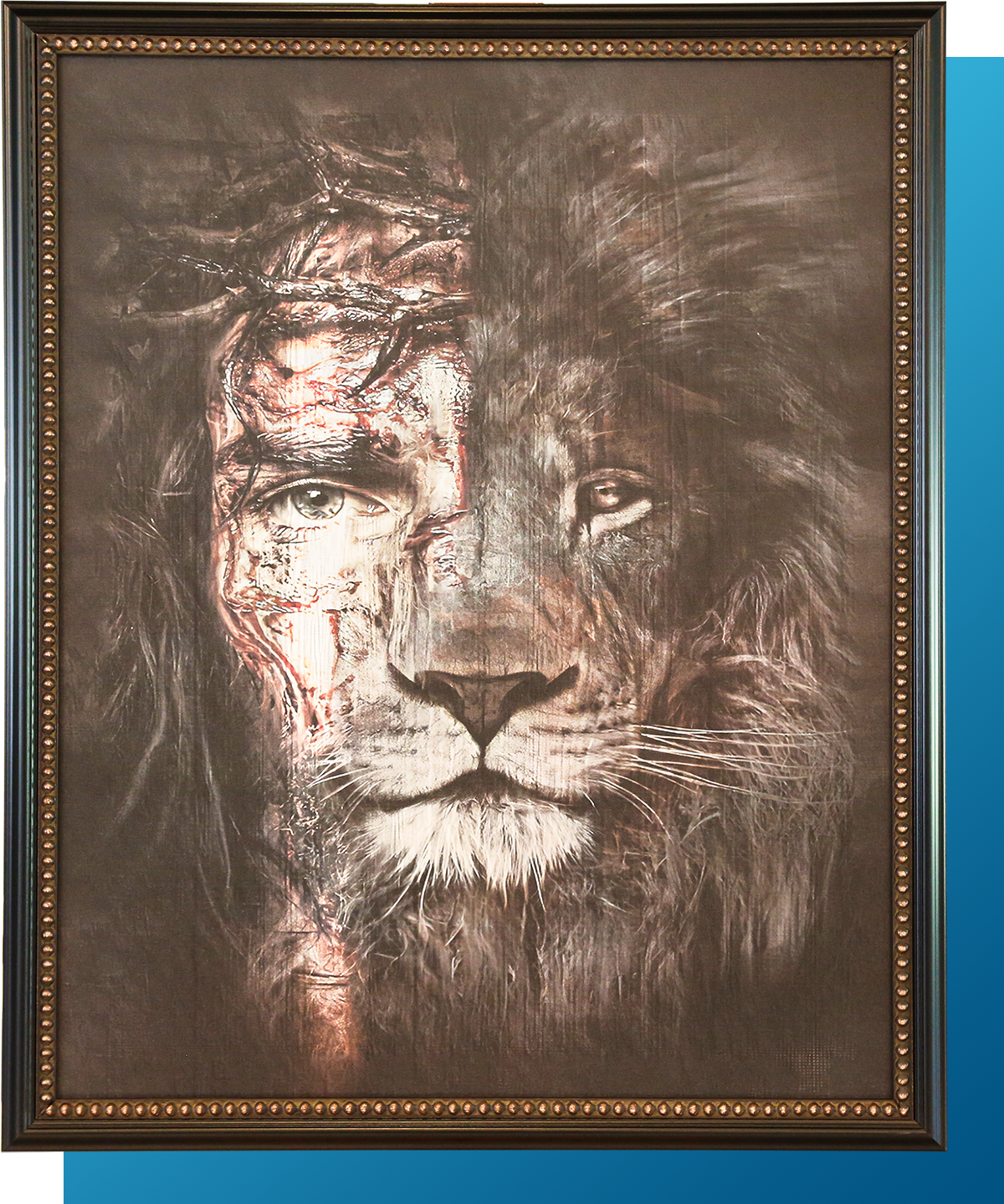
Bethany Church Sanctuary Artwork
Most of us have heard the saying “a picture is worth a thousand words.” There is something about art and craftsmanship that speaks volumes to our hearts and minds. We can appreciate the symbolism present in materials, textures and colors that God selected for the tent-of-meeting in Moses’ lifetime and the temple in Solomon’s day. At Bethany Church, we have incorporated color, unique materials, craftsmanship, and artistry in the sanctuary. We pray that this artistry gives God glory and communicates biblical truths found in his Word. We pray that God will speak to you though this artwork as you pray and worship in this sacred space.
Kintsugi Pottery
Kintsugi is the Japanese art of using gold (and other precious metals) to repair broken pottery. The process is complex, intentional, and contemplative. Upon completion, the once-broken vessels are made whole. They are stronger and possess a different type of beauty than before. Because of the use of gold and the artistry involved, the repaired pottery is of greater worth.
God gave us Jesus to heal our fractured lives. Broken pieces are mended and we are made whole through a relationship with Jesus. He is the artist, mender, peace-giver, healer. Jesus knows what it is like to live with scars. Our mended scars are a beautiful witness to what God has done in our lives.
Have you experienced brokenness in your life? Will you allow Jesus to mend your brokenness? Is there someone in your life who is in need of healing? Pray for spiritual, physical, emotional healing. Tell someone about how God has mended your broken pieces and made you whole.
Related Scriptures to meditate on: Isaiah 61; Romans 5:3 – 5
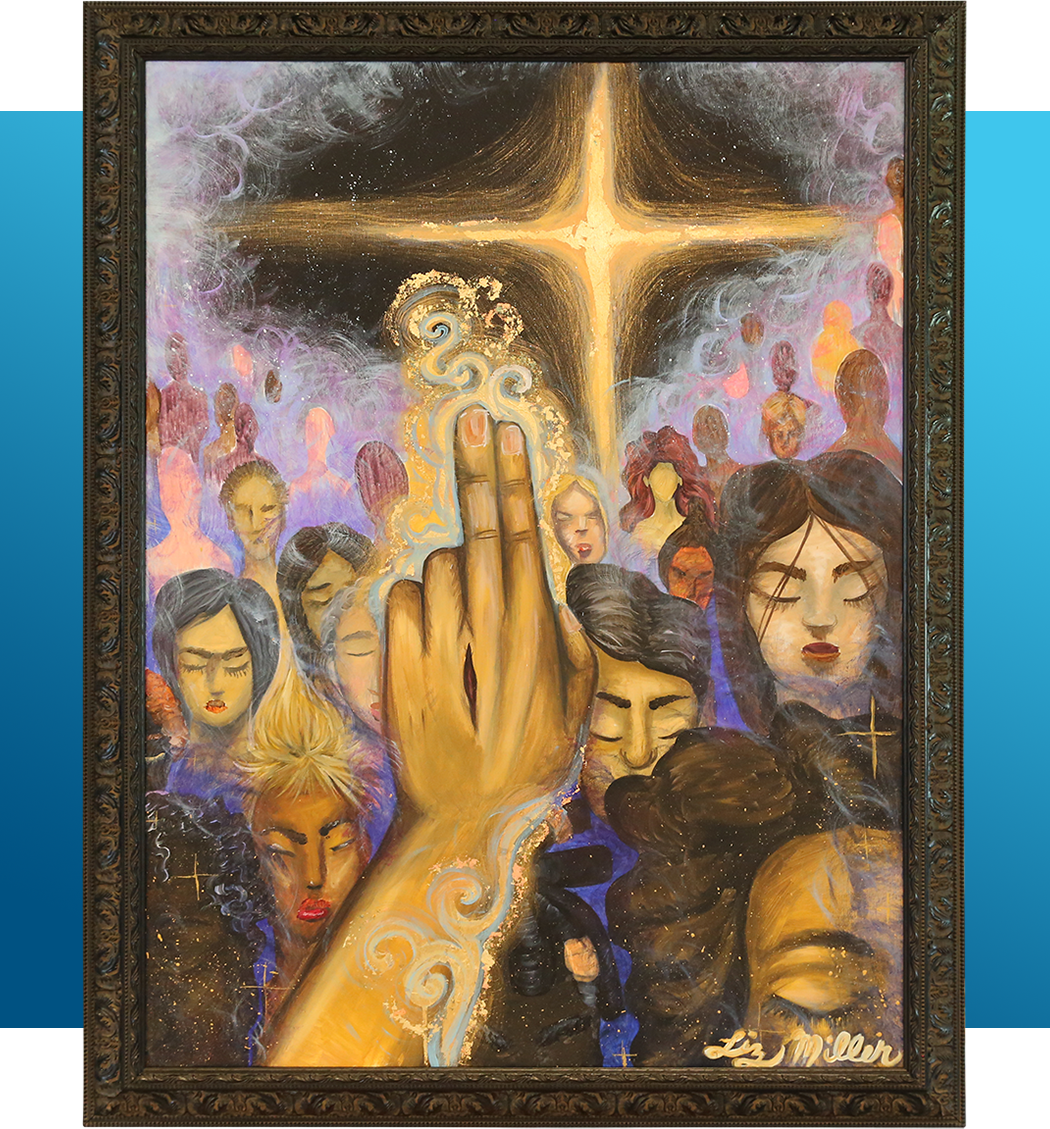
Revelation Worship
This piece was created by Baltimore based artist, Liz Miller. As Bethany Church is a vibrant and diverse worshiping people, Revelation 5 is a passage that resonates with our congregation. Revelation 5:9 and Revelation 7:9 describe a great multitude in heaven standing before the throne of God. Members of the multitude are from every nation, tribe, people, and language. They are people whom Jesus died for.
As we pray the Lord’s Prayer (Matthew 6:10 – 14) we pray for God’s will to be done on earth as it is in heaven. This painting reminds us to pray for God’s people to worship together on earth, in our churches, in the same way that we will worship together in heaven.
Notes from the artist:
At various times of day, the light catches this painting incredibly differently. Morning light seems to set off the warm tones: orangey browns, yellows and golds. The afternoon light strikes the cooler tones, the deep purples and rich blues. The gold leaf, conveying royalty, the divine and the spiritual realm, reflect both high and low light different.
Our connection with the divine can be both activating, exciting, energetic, most often portrayed in warm colors. However simultaneously our engagement with the divine can be peaceful, serene and restful; represented by cool colors. The balance between the two in a single image allows the viewer to vacillate between. This painting acknowledges the journey of on-going growth of the believer.
There are three focal points or foci in the image. The eye is drawn primarily to the two marked by the metallic signifiers, Father and Son. After that the eye roams around the piece picking up the smokiness and the deep rich under-coloring. This is meant to resemble the Holy Spirit, unseen and yet ever present everywhere; in and through us and among us.
God Loves the World
Inspired by the Kintsugi pottery and John 3:16, this piece of artwork designed by Ohio-based artist, Kim Harberson, reminds us of God’s redeeming love to a broken world. The apostle John writes in his gospel of Jesus’ body which was broken for the world. The languages included in the piece represent present members of our own Bethany church family who speak them. We are reminded that we do not worship in isolation but rather as a representation of the global body of Christ. The languages in this piece all communicate the same message – “God so loved the world.” The languages are:
Arabic (Spoken by our Egyptian Families)
Yoruba (Spoken by our Nigerian Families)
Telugu (Spoken by our Indian Families)
Hindi (Spoken by our Indian Families)
Tibetan (Spoken by our Tibetan Families)
English (Our shared language)
Spanish (Spoken by our Hispanic Families)
Mandarin (Spoken by our Chinese Families)
Korean (Spoken by our Korean Families)
We continue to learn of additional languages spoken by those who worship with us and we seek ways to use language in various aspects of our worship.
Notes from the artist:
It was an honor to be asked to create this piece of art for Bethany. The idea that the love of God is for all people in all the world resonates with me, and I tried to capture that message in this piece. In Christian art, blue has historically meant heavenly grace, hope, and servitude. All of these traits are mixed together and poured out on the world in God’s love. If you look closely, you can see a subtle outline of the world in the corner. I also wanted to tie in the golden threads from the Kintsugi pottery. I love the symbolism of the gold being used to repair broken things, just like God’s love can repair a broken world.
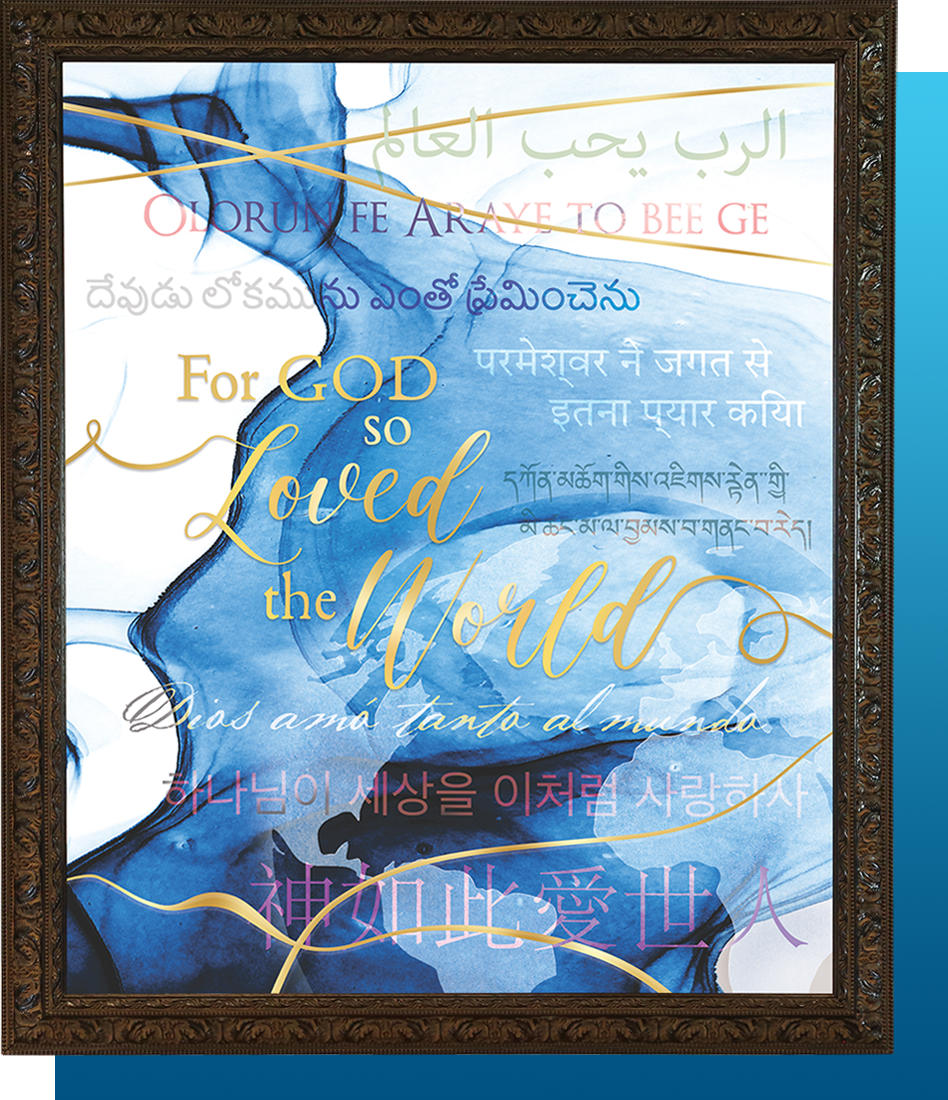
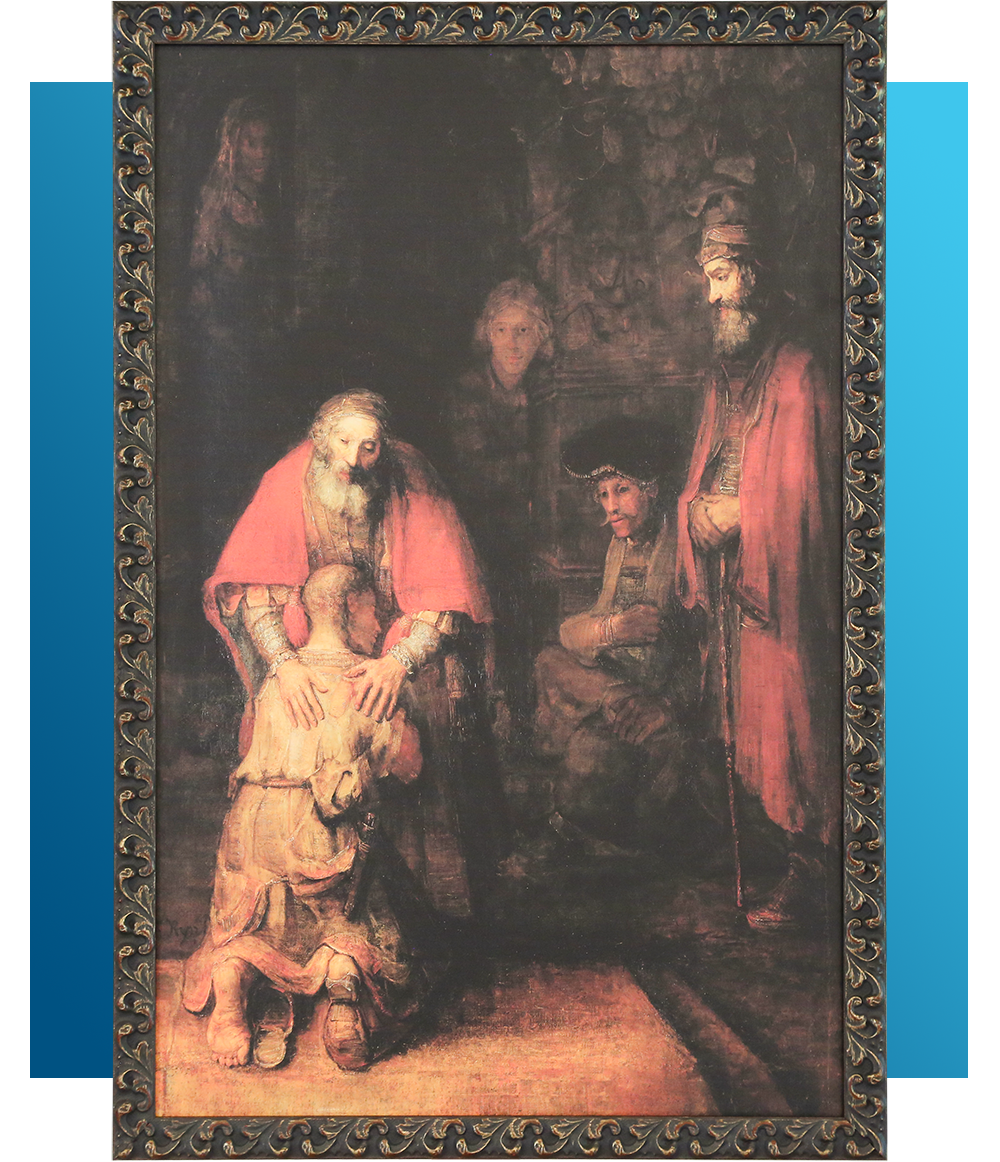
The Return of the Prodigal Son
The Return of the Prodigal Son is a reproduction of an oil painting by Rembrandt. The famous Dutch artist passed away in 1669 and it is believed that this work was painted two years prior to his death. The piece is based on the story of the prodigal son found in Luke 15:11 – 32. In this passage, Jesus shares this 3rd of three parables depicting something or someone of great value, once lost, now found. Rembrandt creates a many faceted expression of the moment when the son returns home to the loving arms of his father. Catholic Priest Henry Nowen became enthralled with this painting as it hung in a museum in St. Petersburg, Russia. He wrote a book by the same title sharing his insights and how God changed his life through this painting. In writing the book, Nowen came to the realization he was truly loved by God. Many people have since sat and contemplated the images in this painting and how they express God, the Father’s, never ending love for his children. To learn more about the painting, The Return of the Prodigal Son, we suggest reading Jesus’ parable in Luke 15:11-32 as well as consulting these resources:
The Return of the Prodigal Son, 1669 by Rembrandt (rembrandtpaintings.com)
Reading group materials (henrinouwen.org)
Amazon.com: The Return of the Prodigal Son: A Story of Homecoming (Audible Audio Edition): Henri J. M. Nouwen, Dan Anderson O.F.M., Franciscan Media: Audible Books & Originals
The Lion and the Lamb
Scripture refers to Jesus as the “lamb of God who takes away the sins of the world” (John 1:29) and the “lamb who was slain” (Revelation 5:12). Because of Jesus’ sacrificial death and resurrection, Revelation 5:5 also exclaims his victory over death when proclaiming “Do not weep! See, the Lion of the tribe of Judah, the Root of David, has triumphed!” (ESV). Each time we celebrate communion together, we both remember Jesus’ sacrifice and rejoice for his triumph. This piece of artwork combines these two depictions of Jesus stunningly as we see him as the sacrificial lamb and the victorious Lion of Judah.
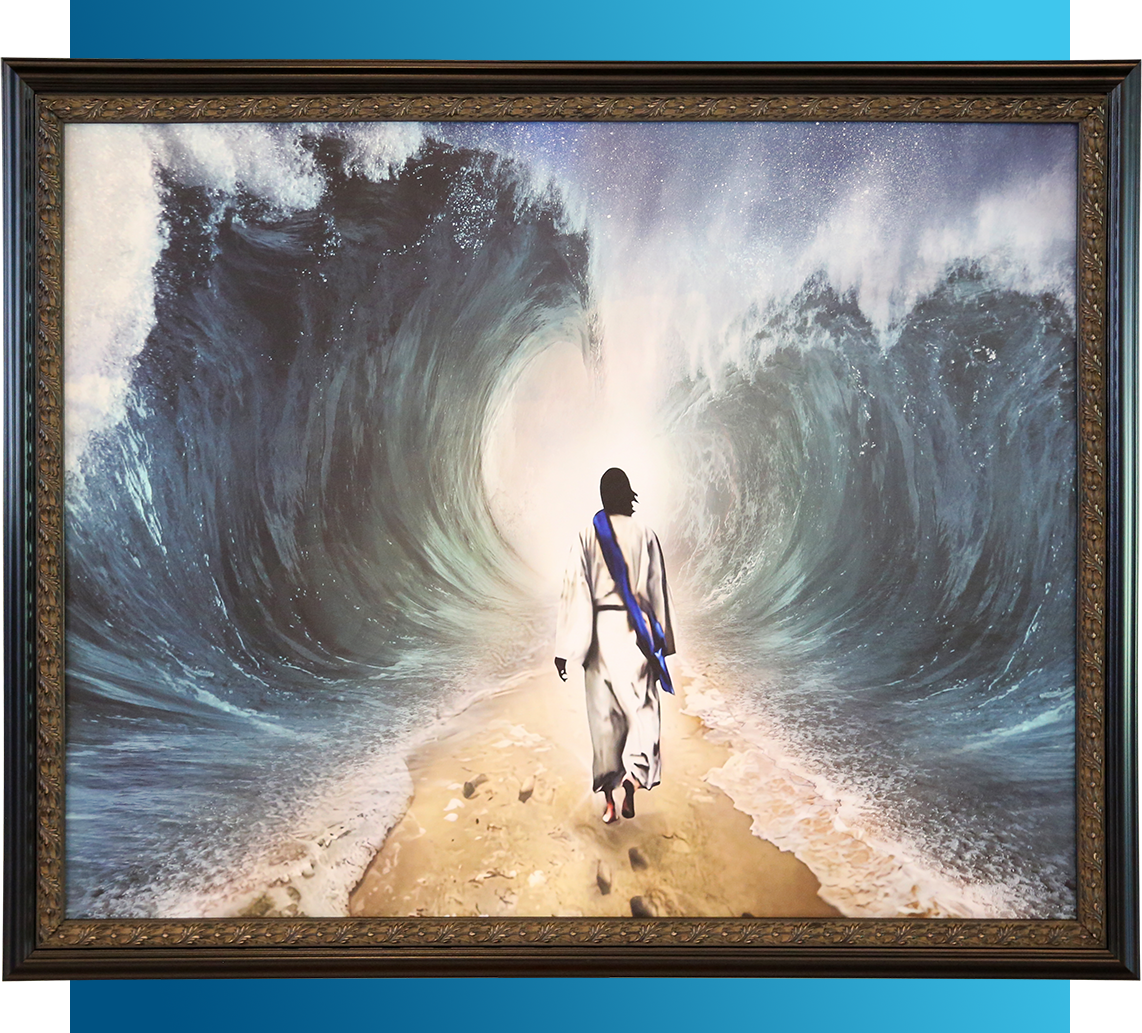
Parting Waters
When thinking of parting waters, we often remember Moses. In this painting, the artist depicts Jesus as the one walking through a parted sea. Although we cannot say for certain why the artist chose Jesus as the one in the middle of the sea, we do know for certain that Jesus has made a way for us to have a personal relationship with God and to deliver us from the bondage of sin into which we were born. Jesus is also Emmanuel, God with us. When we pass through the waters, he is with us. What other symbolism do you see in this painting?
Bethany Church Sanctuary Artwork
Most of us have heard the saying “a picture is worth a thousand words.” There is something about art and craftsmanship that speaks volumes to our hearts and minds. We can appreciate the symbolism present in materials, textures and colors that God selected for the tent-of-meeting in Moses’ lifetime and the temple in Solomon’s day. At Bethany Church, we have incorporated color, unique materials, craftsmanship, and artistry in the sanctuary. We pray that this artistry gives God glory and communicates biblical truths found in his Word. We pray that God will speak to you though this artwork as you pray and worship in this sacred space.

Kitsugi Pottery
Kintsugi is the Japanese art of using gold (and other precious metals) to repair broken pottery. The process is complex, intentional, and contemplative. Upon completion, the once-broken vessels are made whole. They are stronger and possess a different type of beauty than before. Because of the use of gold and the artistry involved, the repaired pottery is of greater worth.
God gave us Jesus to heal our fractured lives. Broken pieces are mended and we are made whole through a relationship with Jesus. He is the artist, mender, peace-giver, healer. Jesus knows what it is like to live with scars. Our mended scars are a beautiful witness to what God has done in our lives.
Have you experienced brokenness in your life? Will you allow Jesus to mend your brokenness? Is there someone in your life who is in need of healing? Pray for spiritual, physical, emotional healing. Tell someone about how God has mended your broken pieces and made you whole.
Related Scriptures to meditate on: Isaiah 61; Romans 5:3 – 5

Revelation Worship
This piece was created by Baltimore based artist, Liz Miller. As Bethany Church is a vibrant and diverse worshiping people, Revelation 5 is a passage that resonates with our congregation. Revelation 5:9 and Revelation 7:9 describe a great multitude in heaven standing before the throne of God. Members of the multitude are from every nation, tribe, people, and language. They are people whom Jesus died for.
As we pray the Lord’s Prayer (Matthew 6:10 – 14) we pray for God’s will to be done on earth as it is in heaven. This painting reminds us to pray for God’s people to worship together on earth, in our churches, in the same way that we will worship together in heaven.
Notes from the artist:
At various times of day, the light catches this painting incredibly differently. Morning light seems to set off the warm tones: orangey browns, yellows and golds. The afternoon light strikes the cooler tones, the deep purples and rich blues. The gold leaf, conveying royalty, the divine and the spiritual realm, reflect both high and low light different.
Our connection with the divine can be both activating, exciting, energetic, most often portrayed in warm colors. However simultaneously our engagement with the divine can be peaceful, serene and restful; represented by cool colors. The balance between the two in a single image allows the viewer to vacillate between. This painting acknowledges the journey of on-going growth of the believer.
There are three focal points or foci in the image. The eye is drawn primarily to the two marked by the metallic signifiers, Father and Son. After that the eye roams around the piece picking up the smokiness and the deep rich under-coloring. This is meant to resemble the Holy Spirit, unseen and yet ever present everywhere; in and through us and among us.

God Loves the World
Inspired by the Kintsugi pottery and John 3:16, this piece of artwork designed by Ohio-based artist, Kim Harberson, reminds us of God’s redeeming love to a broken world. The apostle John writes in his gospel of Jesus’ body which was broken for the world. The languages included in the piece represent present members of our own Bethany church family who speak them. We are reminded that we do not worship in isolation but rather as a representation of the global body of Christ. The languages in this piece all communicate the same message – “God so loved the world.” The languages are:
Arabic (Spoken by our Egyptian Families)
Yoruba (Spoken by our Nigerian Families)
Telugu (Spoken by our Indian Families)
Hindi (Spoken by our Indian Families)
Tibetan (Spoken by our Tibetan Families)
English (Our shared language)
Spanish (Spoken by our Hispanic Families)
Mandarin (Spoken by our Chinese Families)
Korean (Spoken by our Korean Families)
We continue to learn of additional languages spoken by those who worship with us and we seek ways to use language in various aspects of our worship.
Notes from the artist:
It was an honor to be asked to create this piece of art for Bethany. The idea that the love of God is for all people in all the world resonates with me, and I tried to capture that message in this piece. In Christian art, blue has historically meant heavenly grace, hope, and servitude. All of these traits are mixed together and poured out on the world in God’s love. If you look closely, you can see a subtle outline of the world in the corner. I also wanted to tie in the golden threads from the Kintsugi pottery. I love the symbolism of the gold being used to repair broken things, just like God’s love can repair a broken world.

The Return of the Prodigal Son
The Return of the Prodigal Son is a reproduction of an oil painting by Rembrandt. The famous Dutch artist passed away in 1669 and it is believed that this work was painted two years prior to his death. The piece is based on the story of the prodigal son found in Luke 15:11 – 32. In this passage, Jesus shares this 3rd of three parables depicting something or someone of great value, once lost, now found. Rembrandt creates a many faceted expression of the moment when the son returns home to the loving arms of his father. Catholic Priest Henry Nowen became enthralled with this painting as it hung in a museum in St. Petersburg, Russia. He wrote a book by the same title sharing his insights and how God changed his life through this painting. In writing the book, Nowen came to the realization he was truly loved by God. Many people have since sat and contemplated the images in this painting and how they express God, the Father’s, never ending love for his children. To learn more about the painting, The Return of the Prodigal Son, we suggest reading Jesus’ parable in Luke 15:11-32 as well as consulting these resources:
The Return of the Prodigal Son, 1669 by Rembrandt (rembrandtpaintings.com)
Reading group materials (henrinouwen.org)
Amazon.com: The Return of the Prodigal Son: A Story of Homecoming (Audible Audio Edition): Henri J. M. Nouwen, Dan Anderson O.F.M., Franciscan Media: Audible Books & Originals
The Lion and the Lamb
Scripture refers to Jesus as the “lamb of God who takes away the sins of the world” (John 1:29) and the “lamb who was slain” (Revelation 5:12). Because of Jesus’ sacrificial death and resurrection, Revelation 5:5 also exclaims his victory over death when proclaiming “Do not weep! See, the Lion of the tribe of Judah, the Root of David, has triumphed!” (ESV). Each time we celebrate communion together, we both remember Jesus’ sacrifice and rejoice for his triumph. This piece of artwork combines these two depictions of Jesus stunningly as we see him as the sacrificial lamb and the victorious Lion of Judah.

Parting Waters
When thinking of parting waters, we often remember Moses. In this painting, the artist depicts Jesus as the one walking through a parted sea. Although we cannot say for certain why the artist chose Jesus as the one in the middle of the sea, we do know for certain that Jesus has made a way for us to have a personal relationship with God and to deliver us from the bondage of sin into which we were born. Jesus is also Emmanuel, God with us. When we pass through the waters, he is with us. What other symbolism do you see in this painting?

